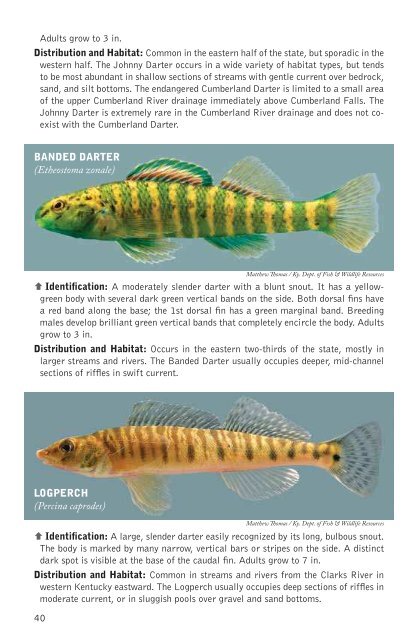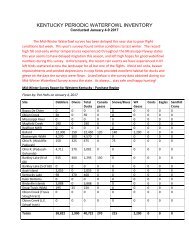Kentucky Fishes
kyfishid[1]
kyfishid[1]
- No tags were found...
Create successful ePaper yourself
Turn your PDF publications into a flip-book with our unique Google optimized e-Paper software.
Adults grow to 3 in.<br />
Distribution and Habitat: Common in the eastern half of the state, but sporadic in the<br />
western half. The Johnny Darter occurs in a wide variety of habitat types, but tends<br />
to be most abundant in shallow sections of streams with gentle current over bedrock,<br />
sand, and silt bottoms. The endangered Cumberland Darter is limited to a small area<br />
of the upper Cumberland River drainage immediately above Cumberland Falls. The<br />
Johnny Darter is extremely rare in the Cumberland River drainage and does not coexist<br />
with the Cumberland Darter.<br />
BANDED DARTER<br />
(Etheostoma zonale)<br />
Matthew Thomas / Ky. Dept. of Fish & Wildlife Resources<br />
Ç Identification: A moderately slender darter with a blunt snout. It has a yellowgreen<br />
body with several dark green vertical bands on the side. Both dorsal fins have<br />
a red band along the base; the 1st dorsal fin has a green marginal band. Breeding<br />
males develop brilliant green vertical bands that completely encircle the body. Adults<br />
grow to 3 in.<br />
Distribution and Habitat: Occurs in the eastern two-thirds of the state, mostly in<br />
larger streams and rivers. The Banded Darter usually occupies deeper, mid-channel<br />
sections of riffles in swift current.<br />
SAUGER<br />
(Sander canadensis)<br />
Ç Identification: A slender, streamlined perch similar to the Walleye (below), but<br />
reaches a smaller adult size. It is distinguished from the Walleye by having at least 3<br />
rows of rounded black spots in the 1st dorsal fin (vs. streaks or wavy lines), 3-4 dark<br />
brown saddles on the back with 2 large dark brown blotches on the side (vs. several<br />
smaller blotches on the back and side), and no white tips on the fins (vs. white tips<br />
on the anal fin and lower lobe of the caudal fin). Adults can grow to 30 in. (8-9 lbs),<br />
but are usually less than 20 in. (2-3 lbs).<br />
Distribution and Habitat: Occurs in most of the large rivers statewide, including the<br />
main channels of the Mississippi and Ohio rivers, their major tributaries, as well as<br />
<strong>Kentucky</strong>, Barkley, and Cumberland lakes. Sauger and Walleye occupy similar habitats,<br />
but Sauger tend to be more tolerant of turbid (muddy) water conditions. Sauger<br />
are often taken by anglers during early spring spawning runs, when they congregate<br />
near swift shoals, near the mouths of streams, or in tailwaters of dams.<br />
WALLEYE<br />
(Sander vitreus)<br />
Matthew Thomas / Ky. Dept. of Fish & Wildlife Resources<br />
LOGPERCH<br />
(Percina caprodes)<br />
Matthew Thomas / Ky. Dept. of Fish & Wildlife Resources<br />
Ç Identification: A large, slender darter easily recognized by its long, bulbous snout.<br />
The body is marked by many narrow, vertical bars or stripes on the side. A distinct<br />
dark spot is visible at the base of the caudal fin. Adults grow to 7 in.<br />
Distribution and Habitat: Common in streams and rivers from the Clarks River in<br />
western <strong>Kentucky</strong> eastward. The Logperch usually occupies deep sections of riffles in<br />
moderate current, or in sluggish pools over gravel and sand bottoms.<br />
Matthew Thomas / Ky. Dept. of Fish & Wildlife Resources<br />
Ç Identification: A large, streamlined perch with an opaque eye, large mouth, and<br />
enlarged canine teeth. The upper jaw extends beyond the middle of the eye. Color is<br />
olive-green to brown with darker blotches on the back and side. The 1st dorsal fin has<br />
dark streaks or wavy bands, and a black botch covering the membranes of the last<br />
few spines. The anal fin and lower lobe of the caudal fin are tipped in white. Adults<br />
can grow to 36 in. (25 lbs), but usually range from 12-30 in. (2-10 lbs).<br />
Distribution and Habitat: Occurs in most of the large rivers statewide, but most common<br />
in the Cumberland River drainage, including the Big South Fork and Rockcastle<br />
River. Several reservoirs across the state are stocked with a Lake Erie strain, but<br />
efforts are also underway by <strong>Kentucky</strong> Department of Fish and Wildlife Resources<br />
to restore a native river-adapted strain to free-flowing sections of selected river systems.<br />
Walleye often occur in deep pools of rivers or open waters of reservoirs with<br />
abundant bottom cover. They will also congregate below dams or near rocky shoals<br />
in rivers.<br />
40 41



